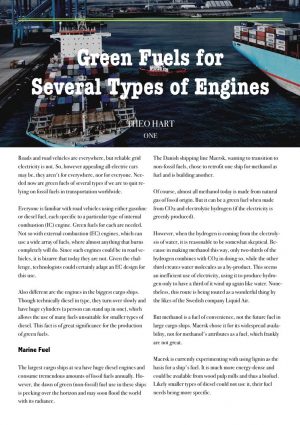 Roads and road vehicles are everywhere, but reliable grid electricity is not. So, however appealing all·electric cars may be, they aren’t for everywhere, nor for everyone. Needed now are green fuels of several types if we are to quit relying on fossil fuels in transportation worldwide.
Roads and road vehicles are everywhere, but reliable grid electricity is not. So, however appealing all·electric cars may be, they aren’t for everywhere, nor for everyone. Needed now are green fuels of several types if we are to quit relying on fossil fuels in transportation worldwide.
Everyone is familiar with road vehicles using either gasoline or diesel fuel, each specific to a particular type of internal combustion (IC) engine. Green fuels for each are needed. Not so with external combustion (EC) engines, which can use a wide array of fuels, where almost anything that burns completely will do. Since such engines could be in road vehicles, it is bizarre that today they are not. Given the challenge, technologists could certainly adapt an EC design for this use.
Also different are the engines in the biggest cargo ships. Though technically diesel in type, they turn over slowly and have huge cylinders (a person can stand up in one), which allows the use of many fuels unsuitable for smaller types of diesel. This fact is of great significance for the production of green fuels.
Marine Fuel
The largest cargo ships at sea have huge diesel engines and consume tremendous amounts of fossil fuels annually. However, the dawn of green (non-fossil) fuel use in these ships is peeking over the horizon and may soon flood the world with its radiance.
The Danish shipping line Maersk, wanting to transition to non-fossil fuels, chose to retrofit one ship for methanol as fuel and is building another.
Of course, almost all methanol today is made from natural gas of fossil origin. But it can be a green fuel when made from CO2 and electrolytic hydrogen (if the electricity is greenly produced).
However, when the hydrogen is coming from the electrolysis of water, it is reasonable to be somewhat skeptical. Because in making methanol this way, only two-thirds of the hydrogen combines with CO2 in doing so, while the other third creates water molecules as a by-product. This seems an inefficient use of electricity, using it to produce hydrogen only to have a third of it wind up again like water. Nonetheless, this route is being touted as a wonderful thing by the likes of the Swedish company Liquid Air.
But methanol is a fuel of convenience, not the future fuel in large cargo ships. Maersk chose it for its widespread availability, not for methanol’s attributes as a fuel, which frankly are not great.
Maersk is currently experimenting with using lignin as the basis for a ship’s fuel. It is much more energy-dense and could be available from wood pulp mills and thus a biofuel. Likely smaller types of diesel could not use it, their fuel needs being more specific.
Interestingly, the use of green fuel in these ships may be done in stages through dual fuelling. Here, two fuels are stored separately and then injected together into the engine in any proportions. Even existing ships may be retrofitted to use dual fueling.
Thus, the green fuel may be a small proportion at first and become the major fuel when it is more available. And one such fuel for these huge diesels may be a future green gasoline.
One Type of Green Gasoline
While methanol and ethanol have low energy densities, making either of them a poor choice as fuel, when chemically combined two to one with a ketone (acetone, say), they become an energy-dense fuel that works as gasoline. In 1956 Dow Chemical patented a means of doing this. (US Patents 2.827.494 and .495 for the details.) But the reaction is reversible, and to get a pure product, the water also formed must be removed. Experience in dewatering the ethanol azeotrope to get pure ethanol could be instructive here.
The best use for these types of gasoline would be in the largest ships’ diesels. Better gasoline for cars is shown later in discussing 2,3·butanediol as a preferred fermentation.
Isolation from Ferments
Generally speaking, the two highest costs of an industrial ferment are the material being fermented (the substrate) and the isolation of the products made, or at least the desired ones.
Distillation or extraction by some means are the most frequent choices, and recovery of some of the energy used is often a means of reducing costs overall. For isolating alcohols, diols or ketones on an industrial scale, salting out has much to recommend it. A cheap and disposable salt, such as sodium chloride (NaCl) or sea salt, is one approach. Another is to use potassium chloride fertiliser (KCl). Either way, a saturated solution of these salts will float the desired products to the surface, where they are readily decanted.
Yes, but what about the salty water left over? Well, with sea salt or sodium chloride simply run it slowly into the sea so as to quickly disperse the overly salty plume. This enriches the area with fermenter debris which marine life will soon consume. The resulting increased harvest of edible filtre feeders and fish should be a welcome development for the locals. In the case of potassium chloride, send the salty water after product removal into an outdoor evaporation pond. Dry it down, scoop out, and pellet for re-sale. It may be marketed as enhanced fertiliser, having besides potassium, some nitrogen, phosphorus, and many micronutrients. As such, it will fetch a higher price – particularly, one would expect, from commercial growers of vegetable crops.
EC Engines
Internal combustion engines do not have clean emissions, whatever fuel is used in them. Smog formation may be a problem. In contrast, an external combustion engine has inherently cleaner emissions, comparable to a furnace burning liquid fuel. Properly adjusted, its smoke is white in cold air.
Such EC engines may use a much broader spectrum of fuels. For example, in 2014, the Swedish company Precer had a vehicle, a fun buggy one might associate with partying round a bonfire at some beach. But this was no ordinary vehicle.
It was a hybrid with electrical storage batteries and an EC engine burning wood pellets as fuel! (I kid you not). Well, that might not have caught on. Also, the engine was a Stirling type of hot air engine, which unfortunately needs very high internal pressures to be powerful enough for a road vehicle. Ford and General Motors, among others, tried it as prototype engines in cars some sixty years ago but then gave up.
A closed-loop turbine, another EC engine, is a far better choice. The working fluid exits a boiler, spins a high-speed turbine (smaller than a dinner plate), gets condensed to a liquid and returns to the boiler. Round and round and round it goes, hence the term “closed-loop”.
DuPont built one circa 1972 primarily to test various chemicals as the working fluid. Their dream was to supply that for thousands upon thousands of these engines in road vehicles. But no car manufacturer took sufficient interest.
The test engine was small (15 kW) and innovative. It featured a rotating boiler, with a rotating condenser on the same shaft and was cooled by air. The centrifugal force pushed the liquid fluid against the outer wall of the boiler, where heat from the open flames vapourised it. This made heat transfer very efficient, contributing to the engine reaching nearly 24% in overall heat efficiency, which is better than gasoline engines in cars.
The design is a good one except for the air cooling of the rotating condenser. It would be too lengthy for an engine large enough for a road vehicle. It should instead be short and rely on a separate cooling system with a radiator, like today’s vehicles. This also provides layout flexibility regarding the radiator.
It is particularly suitable for hybrid vehicles, whether hybrid electric or hybrid hydraulic, where the engine is either run near maximum output or is off. The heat efficiency of this type of engine drops off at partial loading.
External combustion allows a wide choice of fuels for the engine, even the wood pellets of the Swedish fun buggy. A liquid fuel of some sort is naturally much more convenient. Since all any fuel does is must burn completely, many inexpensive fuels would soon be on offer. O welcome change!
Fuels of fossil origin should be banned from use.
This type of EC engine could replace the engines in diesel-electric locomotives. The attraction would be cheap fuel, which is a significant operating expense for railways that rely on diesel power – often, it is second only to wages.
These would be powerful engines, and there are ways of varying their output with minor loss in heat efficiency. A sizeable cooling system for the condenser would be needed, which could be on a separate railcar behind the locomotive, an articulated connexion keeping them permanently joined. Or it could be in front of the locomotive instead.
Why 2,3-Butanediol from Paenibacillus polymixa
There are at least seven good reasons.
One. Readily made into butanone, perhaps better known as MEK, methyl·ethyl·ketone, a solvent with an established market.
Two. Combines with butanone to form a cyclic compound with attachments, a five·member ring having two O atoms, a cyclic di·ether. Expect it should be relatively stable.
Three. Excellent gasoline from only one ferment, which has ethanol as a co-product. (Note that acetone could instead be the ketone, though that would involve more than one ferment.)
Four. A safe ferment, unlike any Klebsiella species that produce 2,3·butanediol which is toxic and require special precautions.
Five. One unique feature not immediately relevant, both hydroxyls are on the same side (Levo isomer); it has a low freezing point and Canadian researchers circa 1950 felt it could re-place ethylene glycol as the antifreeze in a radiator coolant for engines.
Six. It can grow on a good many substrates, starch and glucose in particular, but also pectin, mannose, galactose, cellobiose and xylose. Produces the enzymes α·amalase, xylanase, and inulase. It can therefore utilise hemicellulose directly and cellulose in-directly, perhaps also kelps. Likely it will be able to ferment immature grasses (fresh hay) to a largish degree since that cellulose is not yet as intractable as it later becomes. The enzymes which attack starch should be helpful in this.
Seven. The bacteria show a strong preference for six-carbon sugars and won’t utilise xylose when glucose, starch or cello-biose is present. Thus it is possible to halt the ferment when xylose has accumulated yet not been attacked. The xylose could then be utilised to make furfural, xylitol, or otherwise made use of. [Doing so in strong brine featured in an early patent on furfural.]
Sugarcane as Fuel Crop
One possible substrate might be the tops of sugarcane lopped off and left in the fields at harvest because, being the newest growth, they contain almost no sucrose, the newest growth.
This also suggests using sugarcane as a fuel crop, repeatedly removing the top growth above a certain height – say 1.8 m – and at season’s end, the bottom part would also be harvested and taken to a sugar mill.
If it is a new purpose-built mill, the focus should not be on maximal sugar production but on keeping capital costs down and operating procedures simple: low-cost.
Then the canes would undergo a ferment to rid them of residual sucrose and perhaps the xylans, leaving cellulose and lignin. Removing the lignin would give cellulose fibre the purity required for various industrial uses, such as fibre in composites or making speciality pulps.
Biogasoline could be a good industry for some islands in the Caribbean and tropical Pacific. Perhaps also Mediterranean lands where sugar cane was once grown before the discovery of the New World. Kenaf or sorghum could be another fuel crop in such places.
Recall that cargo ships with their colossal diesel engines can burn such biogasoline, and they consume a considerable amount of fuel annually. Also, they need to refuel periodically and require fuel depots in most parts of the globe.
Road vehicles are seemingly everywhere and need fuel where they are. So a biogasoline industry would be worldwide and welcomed almost everywhere since it is local production creating much local employment. Plus, it often enhances seafood output as well.
Of course, EC engines would pollute less and use a wider array of biofuels, but that is the world of tomorrow. Today’s world needs bio gasoline to stop burning fossil fuels. Worldwide.
Theo Hart





